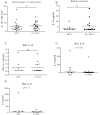Pediatric severe asthma with fungal sensitization is mediated by steroid-resistant IL-33
- PMID: 25746970
- PMCID: PMC4534777
- DOI: 10.1016/j.jaci.2015.01.016
Pediatric severe asthma with fungal sensitization is mediated by steroid-resistant IL-33
Abstract
Background: The mechanism underlying severe asthma with fungal sensitization (SAFS) is unknown. IL-33 is important in fungus-induced asthma exacerbations, but its role in fungal sensitization is unexplored.
Objective: We sought to determine whether fungal sensitization in children with severe therapy-resistant asthma is mediated by IL-33.
Methods: Eighty-two children (median age, 11.7 years; 63% male) with severe therapy-resistant asthma were included. SAFS (n = 38) was defined as specific IgE or skin prick test response positivity to Aspergillus fumigatus, Alternaria alternata, or Cladosporium herbarum. Clinical features and airway immunopathology were assessed. Chronic exposure to house dust mite and A alternata were compared in a neonatal mouse model.
Results: Children with SAFS had earlier symptom onset (0.5 vs 1.5 years, P = .006), higher total IgE levels (637 vs 177 IU/mL, P = .002), and nonfungal inhalant allergen-specific IgE. Significantly more children with SAFS were prescribed maintenance oral steroids (42% vs 14%, P = .02). SAFS was associated with higher airway IL-33 levels. In neonatal mice A alternata exposure induced higher serum IgE levels, pulmonary IL-33 levels, and IL-13(+) innate lymphoid cell (ILC) and TH2 cell numbers but similar airway hyperresponsiveness (AHR) compared with those after house dust mite exposure. Lung IL-33 levels, IL-13(+) ILC numbers, TH2 cell numbers, IL-13 levels, and AHR remained increased with inhaled budesonide during A alternata exposure, but all features were significantly reduced in ST2(-/-) mice lacking a functional receptor for IL-33.
Conclusion: Pediatric SAFS was associated with more oral steroid therapy and higher IL-33 levels. A alternata exposure resulted in increased IL-33-mediated ILC2 numbers, TH2 cell numbers, and steroid-resistant AHR. IL-33 might be a novel therapeutic target for SAFS.
Keywords: IL-33; Severe asthma; fungal sensitization; innate immunity; pediatric; steroid resistance.
Copyright © 2015 The Authors. Published by Elsevier Inc. All rights reserved.
Figures












References
-
- Vicencio A.G., Santiago M.T., Tsirilakis K., Stone A., Worgall S., Foley E.A. Fungal sensitization in childhood persistent asthma is associated with disease severity. Pediatr Pulmonol. 2014;49:8–14. - PubMed
Publication types
MeSH terms
Substances
Grants and funding
LinkOut - more resources
Full Text Sources
Other Literature Sources
Medical

